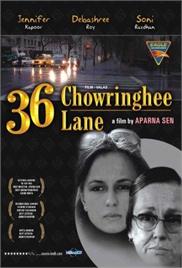Be Careful of Fake Websites. Always use HindiMovies.to domain & Join our Telegram Channel for Latest Updates.

Likes: 2
Views: 3.09K
After the marriage of her niece, Rosemary, Anglo-Indian school-teacher Violet Stoneham lives a lonely life in her single room flat located at 36 Chowringhee Lane in Calcutta, with only a tom cat for company. She is thrilled when a former student, Nandita Roy, looks her up and also brings her boyfriend, Samaresh Moitra, to her flat. Samaresh is an author and likes the solitude of Violet’s flat, and would like to write his new novel there, to which Violet readily agrees to. He likes her antique record-player and she gives it to him as a gift. She hopes she has become part of a family again. It is Christmas time and Violet would like to bake a cake and visit Nandita and Samaresh to surprise them. But is a surprise that awaits her when she reaches her destination.
Duration: 122 min
Released: 1981
IMDb Rating: 7.6/10 (10 Votes)
Genre: Drama, Hindi Movies, Romance
Stars: Dhritiman Chatterjee, Debashree Roy, Jennifer Kendal
Directors: Aparna Sen
Writers: Aparna Sen
Year: 1981
Server 1 – Openload
Watch Part 1
Watch Part 2
Watch Part 3
Server 2 – Dailymotion
36 Chowringhee Lane is a poignant Indian drama film released in 1981 that delicately captures the solitude and emotional landscape of an aging Anglo-Indian school teacher living in Kolkata. Directed by Aparna Sen, a renowned filmmaker and actress known for her deeply humanistic storytelling, this film beautifully blends themes of loneliness, cultural displacement, and unexpected companionship. It is a standout piece in Indian cinema, recognized for its sensitive portrayal of a marginalized community and its refined cinematic approach.
Plot Summary
The narrative revolves around Violet Stoneham, played by the unforgettable Jennifer Kendal, who is an elderly single woman teaching English to young girls at her home located at 36 Chowringhee Lane in Kolkata. Violet's life is marked by routine and isolation; her only companions are her students and her memories of the past. The film delicately unveils Violet's yearning for connection, affection, and acknowledgment in a society that seems to have moved on without her.
Her world turns slightly upside down when a young artist named Nandita, portrayed by Supriya Pathak, rents a room in Violet's large colonial-era flat. Nandita’s free-spirited personality and emotional vibrancy offer a stark contrast to Violet's restrained existence. They bond over time, providing a precious glimpse of friendship and understanding across generational and cultural divides.
The entrance of Nandita's boyfriend creates complex emotional dynamics, underlining Violet's loneliness even more painfully. The film does not resort to melodrama but carefully explores these emotions through subtle interactions, lingering shots, and expressive silence. It’s a heartfelt observation of human connections and the often overlooked struggles of elderly widows who find themselves forgotten in a rapidly modernizing India.
Main Cast and Crew
Director and Writer
Aparna Sen helmed the film as both director and writer, marking one of her seminal early works in directing. Known for her sensitive and humanistic approach, Sen crafted a narrative that celebrates the quiet dignity of its characters, avoiding clichés and sentimental excess. Her storytelling weaves together loneliness and companionship with poetic subtlety, offering a window into a declining Anglo-Indian culture and the changing urban landscape of Kolkata.
Production and Cinematic Style
The film's cinematography and art direction vividly evoke the atmosphere of a decaying colonial past juxtaposed against the modernizing city. The photography captures the claustrophobic yet tender world of Violet’s apartment and the surrounding neighborhood, emphasizing her isolation.
Moreover, the film relies on strong character-driven storytelling rather than elaborate plot devices. The tone of the film is contemplative and restrained, creating an intimate portrait of loneliness and human connection. The screenplay is characterized by its economy of dialogue and expressive silences, allowing viewers to immerse themselves in Violet’s internal world.
Significance and Reception
36 Chowringhee Lane is often hailed as a groundbreaking film in Indian cinema, particularly for its focus on an Anglo-Indian protagonist—a community rarely spotlighted in Indian films. Jennifer Kendal’s performance earned widespread acclaim and remains a touchstone for portrayals of vulnerability and grace in Indian film history.
The film won several awards including the National Film Award for Best Feature Film in English in 1981. It continues to be studied for its elegant storytelling and its empathetic approach to cultural and generational themes.
Music and Songs
Unlike many Bollywood films, 36 Chowringhee Lane does not heavily rely on song-and-dance sequences. Instead, the film uses a minimalistic background score that complements the narrative’s restrained tone. The music, composed by Ustad Vilayat Khan, an eminent sitar maestro, enhances the melancholic and reflective mood of the film without overwhelming it.
Thus, the soundtrack maintains a classical and subtle ambiance fitting the film's mature themes, helping to draw audiences into Violet’s introspective world.
Conclusion
36 Chowringhee Lane stands as a timeless piece of cinema that compassionately explores themes of aging, loneliness, and the search for human connection. With Aparna Sen’s deft direction, Jennifer Kendal’s unforgettable performance, and an evocative portrayal of changing times in Kolkata, the film transcends its specific cultural context to speak universally about the human condition.
This movie remains an essential watch for cinephiles interested in sensitive storytelling, cross-cultural narratives, and the quieter facets of Indian cinema that move beyond the mainstream. Its subtle artistry and powerful emotional core continue to resonate with audiences decades after its release, making it a classic in Indian film history.